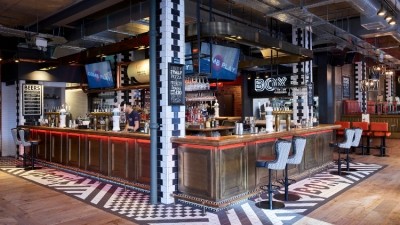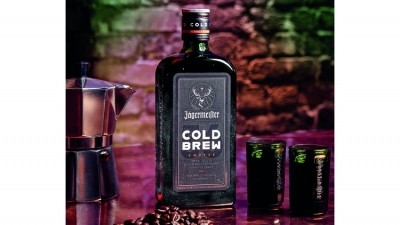What can pre-batch cocktails add to your business?

It’s enough to make the Sex and the City gang choke on their Cosmopolitans. For cocktails are no longer the sole preserve of hip young urbanites, artistic types and those that lunch. Cocktail culture is going mainstream.
The value of the UK cocktail market hit £587m in 2018, with sales up 9.5% year on year, according to CGA statistics. Some 9m people bought a cocktail during the year, up from 8.7m in 2017. In fact, they probably had more than one; cocktail drinkers sink an average of three per drinks-led occasion. So, cocktails are being democratised. How?
A key factor in all this would further chagrin the Sex and the City set: many of the cocktails being knocked back in Britain today are not tailor made as the customer looks on with appetite steadily whetting. Many are made in batches beforehand and mixed with booze once they’re ordered.
“Pre-batch cocktails have definitely enabled far greater availability of cocktails, meaning that we now have a much higher quality of bars serving a much higher quality of drinks,” says Ben Anderson, marketing director at cocktail mixer brand Funkin, quoting CGA numbers.
“A third of all local and community pubs now serve cocktails, a rise of 14% year on year.”
Britain’s best seller
That doesn’t mean we’ve all developed a taste for Whiskey Sours, Negronis and Cosmopolitans, of course. Fruitier drinks are definitely the flavour of the month. Britain’s best-seller is the Porn Star Martini, accounting for 15.3% of all cocktails served, followed by the Mojito, which accounts for 12.4% of sales. The Espresso Martini is another best-seller.
“The popularity of Espresso and Porn Star Martinis is undeniable and they’re two of our best-selling cocktails across our portfolio,” says Martin Wolstencroft, CEO of Leeds-based bar and restaurant operator Arc Inspirations.
“Porn Star Martinis cater to those with a sweet tooth, delivering bold passion fruit and vanilla flavours with the playful ‘chaser’ of Prosecco or Champagne, while the Espresso Martini is arguably the older sibling version – still sweet, but leaning more into bitter coffee notes.”
Jason Simpson, sales director at Simpsons Beverages, which is enjoying booming sales of its range of cocktail mixers and syrups, says sweeter drinks are perennial favourites. “Our classic range of flavours – including Mojito, Strawberry Daiquiri, On the Beach, Pina Colada and Margarita – is extremely popular,” he says.
“Cocktails have helped to transform drinks menus in bars and restaurants across the country, boosting profitability and increasing sales of spirits and liqueurs. Pre-batch mixes are an easy way to offer quick, premium-quality cocktails easily and at a lower cost, which can offer vendors bigger profits or the option to provide attractive two-for-one deals.”
Prepared to pay more
The hefty premium such drinks can command over beers, ciders, wines and spirits with standard mixers has been a key driver of the greater uptake of prebatch cocktails in the pub trade, agrees Funkin’s Anderson.
“Consumers are prepared to pay more for cocktails,” he says. “The average price of a cocktail in a pub is between £5 and £7. According to CGA, the average price consumers expect to pay is £6.77 outside London, and £7.67 in London. What’s interesting is that this has gone up by 51p year on year.”
This is more proof of the trend towards quality of drink over quantity, says David Smillie, portfolio ambassador at drinks distributor Maverick Drinks, which has recently launched a range of premixed cocktails under the That Boutique-y Gin Company brand, available in kegs and 330ml cans and in four variants, including cherry gin & cola and yuzu gin Collins.
“The growth of cocktail culture in Britain is a continuation of the trend of people drinking less but better,” says Smillie, who helped develop a system that allowed Espresso Martinis to be served from the tap in Melbourne, Australia, before joining Maverick.
“People recognise and understand the quality that goes into a cocktail, so they are prepared to pay more for it. Being able to offer quality cocktails quickly and efficiently means that cocktails can now be sold in high footfall venues. The response to our That Boutique-y Gin Company range has been absolutely phenomenal.”
Such lines do more than raise the amount punters end up spending in a venue, however. “Batched cocktails allow the on-trade to offer consistently high-quality cocktails with much more speed while effectively reducing waste with a one-bottle solution, therefore avoiding the use of perishable ingredients,” says Nick Wall, founder and CEO of Tails Cocktails.
“This offers an easy solution for the on-trade as bars and restaurants strive to become more sustainable. We create premium crafted and batched cocktails available in multi-serve bottles and on draught to deliver perfect serves with every pour.
The cocktails provide an innovative solution to reducing long waiting times and ensuring higher quality of serves.”
Most popular mixes
Some sound a note of caution, however. Most cocktail mixes can be stored at room temperature and have a shelf life of 10 days once opened, helping to minimise wastage. But for pub operators new to the cocktail game, it’s important to start with a smaller range of the most popular mixes, says Mitchells & Butlers spirit category manager Martin Lockley.
“While it is important to innovate and offer something new to consumers, the main classic cocktails; Mojito, Pornstar Martini, Espresso Martini, Cosmo, etc, are still what consumers expect to see, which is why it’s sometimes best to try and take a twist on these classics when looking for the next big thing,” he says.
“Across our estate, we will always have brands where cocktails play a key role, but we are also seeing demand for cocktails and mixed drinks in other areas of our portfolio. In these cases, it’s important to ensure that the drinks created are not too complex for team members to make, so that the guest is never disappointed with what they get.”
Many contend that tap dispense systems that work in the same way as beer pumps (or in some cases connect to existing beer dispense systems) are the future of pre-batch cocktails. “Serving cocktails on draught is a fantastic way to enhance customer engagement and build on the overall bar experience,” says Wolstencroft.
“Streamlining cocktail service allows the team to serve more customers but, most importantly, give more time to the customer. The importance of bartender engagement can be a huge anchor for any business so we continually review our operations to see how we can improve.”
Growth in the market
This summer, Grey Goose Vodka unveiled what it claimed was the world’s first ‘sub-zero cocktail draught tap system’ before touring London bars with the innovation. And it’s not just Grey Goose.
“We launched our range of keg cocktails at the beginning of 2018 and the response has been amazing,” says Funkin’s Anderson.
“It can be plugged into a standard beer line and, within 15 seconds, you can serve your customers with a carbonated Mojito or Pink Gin Fizz. It works really well at high-volume times and in beer gardens.
At the moment, 48% of cocktail consumers drink cocktails when they go to the pub, so there’s still so much more room for growth in this market. I would expect to see many more of the larger pub operators adopting keg systems in the future.”
Lockley at Mitchells & Butlers confirms that while still ‘a relatively small part’ of the pub group’s offer, such offerings are in significant growth. “Pre-batch solutions have moved on greatly over the past few years,” he says. “The consistency of serve combined with a high-quality product has allowed bar teams to serve great-tasting drinks more frequently.”
There’s a time and a place for such things, however. e growth of the Turtle Bay chain of Caribbean bars and restaurants has helped drive consumption of cocktails in recent years, with its total number of outlets now standing at 42. The chain specialises in rum cocktails made from scratch, says founder and MD Ajith Jayawickrema.
“Of course, pre-mix cocktails have their place but when you have a cocktail list of more than 30 different serves, you cannot be relying on them – you need to be making them to order,” he says.
“Our clientele are looking for the experience and theatre of having a cocktail mixed for them. They want something that they can’t get at home.”
Cocktail culture
Enter, the nitro cocktail tap serve. A growing number of players (including Grey Goose with its aforementioned sub-zero tap) are rolling out systems that inject nitrogen into the cocktail at the point of serve to give a creamy head to the drink, as if it has been shaken by hand. They’re also designed to create excitement and theatre around prebatched cocktails.
“Our new draught system is a ground-breaking innovation that captures the imagination of cocktail culture,” said Grey Goose’s chief marketing officer on announcing the launch of the sub-zero system in June. “It brings more opportunities for cocktail lovers to treat themselves, without having to compromise on the quality of their drinks.”
Funkin, meanwhile, launched its own nitro system in July. “It’s a simple box plug that it’s in a standard keg that injects the drink at the point of serve to give it that head,” adds Anderson. “It’s very much aimed at creating that ‘I want one of those’ appeal.”
So how many pub operators will want one of those too?










